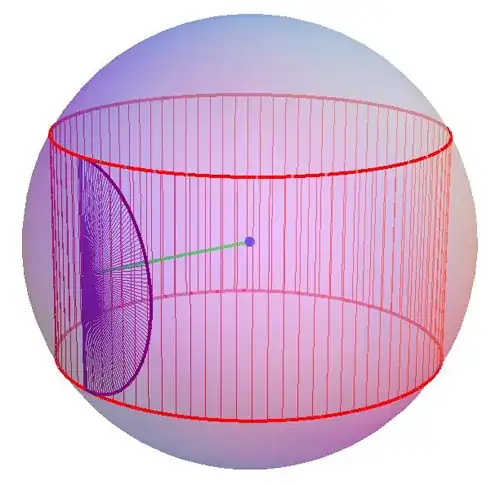The key in seeing this lies in breaking it down into a series of stacked washers or discs.
Define the napkin ring of height $h$ as being hollowed out of a sphere of radius centered at the origin with radius $R=\alpha h$, with $\alpha\ge1$
Define the hole as being drilled along the $z$-axis, creating the napkin ring with an outer diameter $r_\text{out}$ and inner diameter $r_\text{in}$ defined as functions of $z$.
$r_\text{out}=\sqrt{R^2-z^2}$ and inner diameter $r_\text{in}=\sqrt{R^2-(h/2)^2}$
Define the volume as the integral over $z$ ranging over ($-h/2, +h/2$)
$$\pi \int_{-h/2}^{h/2} (r_\text{out}^2-r_\text{in}^2) \, dz$$
as the volume being height ($dz$) multiplied by the area ($\pi r_\text{out}^2 - \pi r_\text{in}^2)$ of the outer disk minus the inner disk. Note that the $R^2$ cancels out, showing that the radius of the sphere of material does not affect the AREA of the annulus at height $z$.
This is the intuitive step that may be hard to grasp. The thickness of the napkin ring ($r_\text{out}-r_\text{in}$) certainly does change with the radius $R$ of the carving sphere. As $R$ increases, the thickness of the napkin ring decreases inversely proportional to the square of $R$. This inverse relationship is what keeps the areas of the annuli at height $z$ at a value that is independent of $R$.
The intuitive mis-step is in thinking that even as $R$ increases, the thickness of the napkin ring stays the same. This is incorrect. A similar intuitive mis-step also occurs with this example.
You are wearing a belt of circumference 1 meter. You let out the belt ~31.416 centimeters (~ ten belt notches). How far over your body will the belt float? (also, how much larger can you now become?) The answer is 10 centimeter increase in radius.
The earth is wearing a belt at its equator of circumference $C$. How much do you have to let the belt out to create a an increase in radius of 10 centimeters for the earth? The answer is the same $\sim31.416$ centimeters, since circumference is linearly proportional to radius. $C=2\pi r$
In the napkin ring problem, the key is that the area of the annuslus as a function of distance along the longitudinal-axis remains constant despite any change in $R$ because of the inverse-square proportionality. Intuition fools us into thinking that the thickness must remain constant for such a thing.
